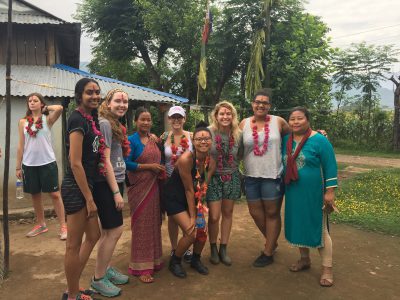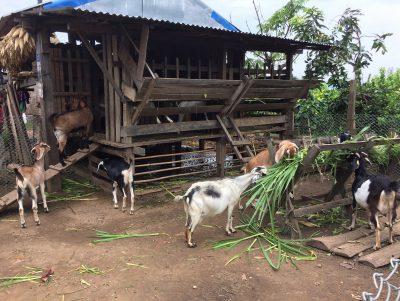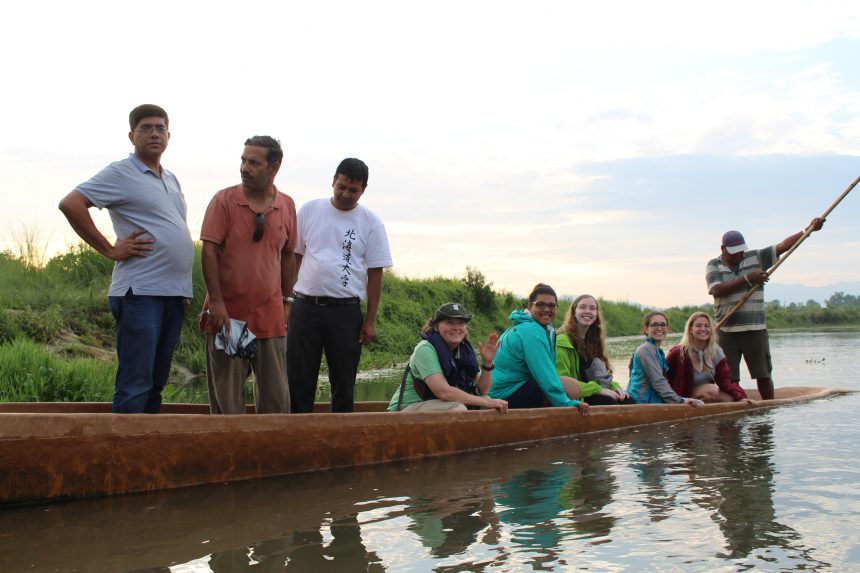Day Fifteen
by Morgan Darter
Today, we got to see the work of Heifer International Nepal. We visited a village that works with Heifer to increase their income by raising meat goats. We were greeted by the women’s co-op, who were all dressed in coordinating outfits. They gave us a blessing with pink powder on our foreheads and a garland of beautiful flowers. They then took us around to their individual farms to see their goats. Afterward, we gathered in their meeting hall, where they gave us an official welcome. It included speeches, a song they had written for us, and a candle lighting ceremony. The co-op was started in 2012, and there are 25 members. It is an incredible way to empower the women of the community. Before the co-op was started, women often did not leave their houses or interact with each other. Now, they meet twice a month to share information and work on community projects.
The goal of the program is to allow the community to become self-sustaining. Heifer provides training to a small group of women, who then educate the rest of the women in their community. Heifer also provides female goats to families. When the goats have offspring, they are given to another family. The goats are raised until they are about a year old, at which point they are sold by weight to the market. The income enables families to purchase other animals, like chickens for eggs or buffalo for milk. This is important, as protein deficiency is a major contributor to malnutrition in Nepal. The village we visited has doubled their goat population since Heifer began the program.
After leaving the village, we traveled to get lunch at The New Kitchen Café, our typical lunch spot. We enjoyed chow mein and fried paneer. After, we drove an hour to the National Trust for Nature Conservation (NTNC), where we would be staying for the next few days.
It is the housing of our dreams, as we can observe elephants less than 10 strides from our windows, and there is a resident baby rhino that wanders around the premises. We attended two lectures about the work of the NTNC and then split up to explore. Some of us went into town, and I went with a group to see the elephants. It was feeding time, and the elephants were getting grass balls filled with beans, rice, salt, and molasses. Their caretakers answered all of our questions and even allowed us to feed and pet the elephants. There are five resident elephants and one young calf. There is also a wild bull elephant that likes to come here and just hang out. We had dinner at NTNC conveniently right next to our barracks. We are grateful for the hospitality of NTNC (as well as for the mosquito netting), and look forward to the adventures in the upcoming few days!


Day Sixteen
by Becca Tanner
Our first morning at Chitwan National Park was an early one. When we arrived the night before, we were greeted by a barrage of wildlife that created a buzz of excitement all around our barracks. Everyone planned to be up at the crack of dawn to see rhinos bathing in the nearby river and the elephants being fed their breakfast. I don’t think any of us hit snooze when our alarm clocks went off around 5 a.m.
When I walked outside of my room to get hot water for my instant coffee, there was a baby rhino casually grazing just a few feet away. He is an orphan who is being cared for after being attacked by a leopard when he was less than one month old. He strolled along the property, not seeming to pay too much attention to us, even as we clambered for our cameras and exclaimed how cute he was. He will live here until he is strong enough to survive on his own in the wild, and then he will be relocated and released in the National Park.
The elephants’ stalls were about 100 feet from our rooms, and we could hear them rumbling and getting eager for their breakfast. Each morning, they are fed rice, beans, salt, and molasses wrapped neatly in a makeshift pouch of elephant grass. One of the elephants ate her breakfast out of a wheelbarrow, but some were hand-fed. We were lucky enough to help out with the feeding.
There were six elephants, all female except for one who is a young bull calf. They ranged in age from 1–70 years—or more. In the morning, they come to get breakfast from their mahouts, or caretakers, and then they are free to graze and explore the vast acreage that spans beyond their stalls. There are three generations of elephants here. The grandmother of the calf (Mankali) stays in the stall next to the mother and baby (Prokriti and Raja). In the wild, female elephants within a family will live their entire lives together, never leaving each other’s side. It was interesting and gratifying to see the family dynamic somewhat kept together in captivity.
Our elephant fun was not over for the day yet, as we headed to the Elephant Breeding Center after breakfast. The Center was a short walk across a river via a bridge that was mostly a sturdy combination of sandbags, sticks, and cement pillars. We first walked into an information center that gave us the history of elephants in Nepal, their ecology, breeding information, and what it takes to manage these large animals in captivity. We read quickly and trekked excitedly towards where the elephants are kept.
What happened next is something I can only reasonably call a baby elephant heyday.
The first calf we walked up to was keen to say hello to us, and walked alongside the fence where we stood, sniffing the air with his trunk. He made a beeline to a break in the fence, closed up by one string of wire. He started to stick his head under, playfully reaching toward us with his trunk. As we took pictures and watched in amusement, he managed to squeeze himself out from under the wire, and walked directly toward a large bundle of grass hay. Another calf in the enclosure got smart and walked the long way around the fence, and also made his way toward the hay. As hilarious and adorable as it was, we knew this was naughty behavior. As it turns out, so did the calves because when they saw their mahouts approaching, they rushed right back behind the fence. From there, we walked around, occasionally stopping to take pictures with a calf or to watch them prance around the tourists there.
All of the calves are conceived naturally, never through artificial insemination. When a female elephant is in estrus, she will trumpet and release pheromones that will attract a wild bull in musth, which is equivalent to a dog being in heat. It can be dangerous to have a wild bull in the premises, as their behavior is unpredictable and they are monstrously strong. Usually, the breeding will take place over several days, and the bull will return to the wild after hopefully impregnating his chosen mate. After nearly two years of gestation, a calf will be born.
We reluctantly left the Breeding Center and headed back to the Biodiversity Center for lectures. We heard about everything from tiger conservation to human and wildlife conflict in Nepal.
After lectures, we wandered around town before retiring for the night, making sure to stop and see the elephants eat their dinner before chowing down on ours. I never knew watching an animal eat could be so fascinating until I saw an elephant maneuver through a meal with her trunk.
Per usual, we went to bed tired and gratified from a full day of exploring the seemingly endless wealth of knowledge and wonder that is Nepal.
Day Seventeen
by Nikita Smith
Today, we got to go on a Jeep Safari! How cool is that? We had to take a canoe across the river to get to the Jeeps from our hotel. Once everyone got across, it started to rain. We hopped in the Jeeps and started our venture! We drove for about two hours to get to headquarters for the national park and saw some spotted deer, a crocodile, and peacocks along the way.
Once we arrived at the headquarters, we had a quick lecture on an overview of wildlife conservation policy in Nepal by Chief Warden Ram Chandra Kendal. We learned some interesting facts and more about how the park runs. We then took a quick ride over to the Crocodile Breeding Center, and learned that they started the Breeding Center in 1987. They have two male crocks there that they breed with the females. One fact I thought was interesting was that when the eggs are laid, the temperature determines the sex of the crocodile. At 32C produces males only. Anything above or below would be a female. Then, we walked over to their Vulture Breeding Center, which was started in 2008. We didn’t get to actually see them, but they had a monitor with all the cameras so we could watch them that way. They have nine different species of vulture in Nepal, and they are currently raising the White-Rumped Vulture.
On our way back to wrap up our adventure, the weather was finally on our side. The rain stopped and the sun finally came out! We saw more deer and wild boars, but what was even more exciting was seeing a sloth bear and her two cubs! It was so amazing to see wild bears! Traveling a little bit further, we could see a beautiful view of the mountains and stopped at a view tower to get up a little higher for a nice picture as the sun was setting. All and all, today was an amazing day! So sad our trip is coming to an end.

Day Eighteen
by Whitney Chandler
It is our last morning here on the reserve. We are all packing and getting ready to go back to the university for our presentations. After breakfast, we took a trip down the river in the park. The canoes were long and skinny, making it more unstable than what we were used to. They are very similar to the boats that people use in crew, minus the long oars. We took two of the boats for a peaceful ride downstream. We saw lots of crocodiles and deer along the bank. One of the boat masters in the back decided to poke one of the crocodiles, which made it turn and snap at his stick. Being so close to the water and animals that have the ability to harm you was a humbling experience. After, we headed back for lunch before we traveled the two hours to the dorms.
Back at AFU, nerves were high as we prepared to give our presentations. We presented to the highest staff at AFU, and everyone did great. It was amazing how much we all learned in such a short time. Most of us knew nothing about the diseases that we picked three months ago. Now, I can tell you all about my pathogen, Kala Azar. I can tell you why it is a problem and what could be done about it. The presentation felt like our true closure to study abroad. It was like finishing your last final. You look back with joy that it’s over, but sadness that it is the ending of a great experience.
The staff at AFU presented Dr. Wilkins with a Token of Friendship. This token signifies the relationship that has been formed between the two universities. It is a true honor to be one of the first students on this trip. We all received AFU hats as tokens of congratulations and friendship from the vice chancellor. These three weeks went by way too fast.
Before we all went to bed to wake up for the early start to a long journey, Dr. Subir and his lovely family bid us farewell with gifts. They also gave us a local dessert that was essentially spongy bread soaked in sugar water.
Before they left, we gave Dr. Subir a signed flag as a gift. He was nothing short of spectacular. He was there every step of the way making sure we were always busy, always safe, and having a good time. I have hopes to come back and visit him.
Day Nineteen
by Dr. Melinda Wilkins
Today, we left behind the hot and steamy plains and headed back to Kathmandu. The students are relaxed and proud of themselves, as they should be. Our presentations yesterday went very well and the students were very professional as they kept talking, despite the extreme heat with lights, fans, and projectors flickering on an off. It was another long, bumpy, and hot bus ride, but the Kathmandu Guest House felt like a cool, calm oasis when we finally arrived. We thanked our trusty bus driver (Bhaji) and his assistant (Laxam) for their excellent (and safe!) driving. The students quickly headed off to finish up souvenir shopping while I worked to balance our accounts— we had enough for one more group dinner!
I find myself already thinking about next year and reflecting on which parts of the program went well and what could or should be changed. I’m already looking forward to returning with a new batch of students, and I’m grateful for all the great connections and friendships we established this year. I have found the Nepalese people to be amazingly and uniformly generous and warm hearted, quick with a smile and always positive. Aside from all the academic content, I hope the students will appreciate their exposure to a culture so different from our own, so incredibly laid back and happy. Our group will scatter tomorrow, some heading home, some heading elsewhere, and some staying a few more days to explore. I can’t wait to see how this trip will influence each student and hope to keep in touch into the future. Namaste Nepal!
